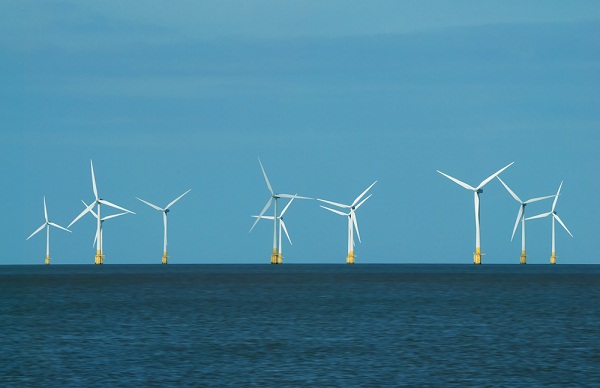Offshore wind power, attractive for so many reasons but right now rather expensive, could get another notch in its plus column under an MIT scenario that calls for the addition of utility-scale storage literally under the turbines.
“Storage spheres” – giant concrete canisters – are the key to what the MIT researchers call the Ocean Renewable Energy Storage (ORES) system.

The idea is that when offshore turbines are producing more electricity than the grid needs – overnight or on weekends, for instance, when demand is slack – power would be used to pump seawater out of the hollow spheres placed at the seafloor beneath the turbines. When extra power is needed, the system would take advantage of hydrostatic pressure, opening up to suck water back into the spheres, with the water passing through a hydropower turbine to generate electricity.
According to an MIT release, “One such 25-meter sphere in 400-meter-deep water could store up to 6 megawatt-hours of power … that means that 1,000 such spheres could supply as much power as a nuclear plant for several hours — enough to make them a reliable source of power.”
Careful readers might have been struck by the water depth MIT is talking about for this concept: 400 meters is far deeper than anything employed now for offshore wind. Most turbines being installed in Europe these days – the only place in the world where offshore wind is yet of consequence – are in waters less than 30 meters deep. The MIT researchers say their system would need to operate in waters at least 200 meters deep to be “economically feasible … with cost per megawatt-hour of storage dropping until 1500 meters before beginning to trend upward.”
The MIT researchers assume that their turbines would float – a not unreasonable assumption for the long-term. Floating turbines are an area getting solid R&D attention these days, as developers aim to operate in waters deeper than 50 meters, where they could take advantage of superior wind conditions, while also likely facing fewer conflicts.
The MIT researchers actually see their spheres – made of concrete, with three-meter thick walls and weighing “thousands of tons apiece” – doing double duty: storing energy, and anchoring the floating turbines.
As for the economics: the researchers say “preliminary estimates indicate that one such sphere could be built and deployed at a cost of about $12 million … with costs gradually coming down with experience. This could yield an estimated storage cost of about 6 cents per kilowatt-hour, a level considered viable by the utility industry.”
And what about the carbon-dioxide emissions from all that cement production? The researchers say they have that covered:
(T)he team calculated that the concrete for these spheres could be made, in part, using large quantities of fly ash from existing coal plants — material that would otherwise be a waste product — instead of cement. The researchers calculate that over the course of a decade of construction and deployment, the spheres could use much of the fly ash produced by U.S. coal plants, and create enough capacity to supply one-third of U.S. electricity needs.
This concept is detailed in a paper published in IEEE Transactions and co-authored by Alexander Slocum, the Pappalardo Professor of Mechanical Engineering at MIT; Brian Hodder, a researcher at the MIT Energy Initiative; and three MIT alumni and a former high school student who worked on the project.